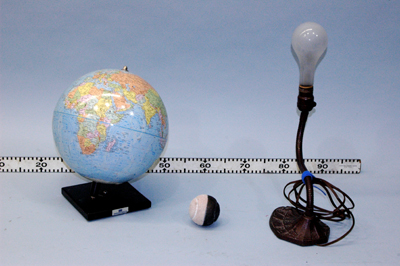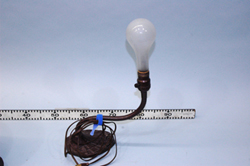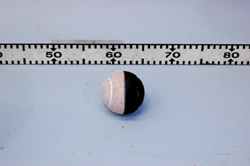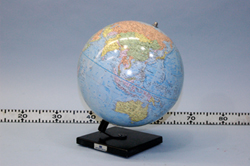|
Size: 1501
Comment:
|
← Revision 3 as of 2013-07-12 18:17:43 ⇥
Size: 2236
Comment: converted to 1.6 markup
|
| Deletions are marked like this. | Additions are marked like this. |
| Line 2: | Line 2: |
| ||<:30%>[:PiraScheme#Mechanics: Table of Mechanics Demonstration]||<:30%>[:MEEquipmentList: List of Mechanics Equipment & Supplies]||<:30%>[:Demonstrations:Lecture Demonstrations]|| | ||<:30%>[[PiraScheme#Mechanics| Table of Mechanics Demonstration]]||<:30%>[[MEEquipmentList| List of Mechanics Equipment & Supplies]]||<:30%>[[Demonstrations|Lecture Demonstrations]]|| |
| Line 7: | Line 7: |
| Planetary Astronomy, [:PlanetaryAstronomy#InertiaofRest: 1F20. Inertia of Rest] | Planetary Astronomy, [[PlanetaryAstronomy#EarthMoonMechanics| 8A20. Earth-Moon Mechanics]] |
| Line 10: | Line 10: |
| * '''Cabinet:''' [:MechanicsCabinet:Mechanic (ME)] * '''Bay:''' [:MechanicsCabinetBayA1:(A1)] |
* '''Cabinet:''' [[MechanicsCabinet|Mechanic (ME)]] * '''Bay:''' [[MechanicsCabinetBayA1|(A1)]] |
| Line 14: | Line 14: |
| attachment: mainPhoto | {{attachment:LightGlobeBall-01-400.jpg}} |
| Line 18: | Line 18: |
| Insert succinct description of demonstration. | A 10" globe, a painted tennis ball, and a 100 W bulb are used to represent the Earth-Moon-Sun system. |
| Line 22: | Line 22: |
| ||apparatus||ME, Bay B1, Shelf #2|| || ||all other parts||ME, Bay B1, Shelf #2|| || ||...||ME, Bay B1, Shelf #2|| || |
||10" Globe||ME, Bay B1, Shelf #2|| || ||Painted Tennis Ball||ME, Bay B1, Shelf #2|| || ||100 W Bulb in Lamp||ME, Bay B1, Shelf #2|| || |
| Line 28: | Line 28: |
| * ''''' ''''' | * N/A |
| Line 33: | Line 33: |
| 1. List steps for setup then procedure. 1. ... |
1. Place the globe, painted tennis ball, and lamp on the lecture bench. 1. Plug in the lamp. 1. Use the setup to model/discuss phases of the moon, eclipses, seasons, days, etc. |
| Line 37: | Line 38: |
| * | * The bulb will get hot. Keep it away from flammable items! |
| Line 41: | Line 42: |
| The earth - moon system is important to study. The moon has a large influence on Earth whether it be on ocean tides or on human cultures. The tilt of the earth gives us our seasons. Also, were at a kind of "sweet spot" away from the sun that allows for our habitable climate. It also happens that for our distance from the sun and our distance from the moon, the moon is just big enough to give us the visually striking eclipses that we see from Earth. | |
| Line 42: | Line 44: |
| Discuss the physics behind the demonstration, explaining some of the various steps of the demonstration when appropriate. ||attachment: photo||attachment: photo||attachment: photo||attachment: photo|| |
||{{attachment:LightSource-01-250.jpg}}||{{attachment:PantedBall-01-250.jpg}}||{{attachment:SmallGlobe-01-250.jpg}}|| |
| Line 47: | Line 47: |
| * [https://www.youtube.com/user/LectureDemostrations/videos?view=1 Lecture Demonstration's Youtube Channel] | * [[https://www.youtube.com/user/LectureDemostrations/videos?view=1|Lecture Demonstration's Youtube Channel]] |
| Line 51: | Line 51: |
| * List any references | * [[http://www.infoplease.com/ce6/sci/A0859764.html|The Earth - Moon System - infoplease.com]] |
| Line 54: | Line 54: |
| [:Instructional:Home] | [[Instructional|Home]] |
Earth-Moon-Sun Model, 8A20.64
Topic and Concept:
Planetary Astronomy, 8A20. Earth-Moon Mechanics
Location:
Cabinet: Mechanic (ME)
Bay: (A1)
Shelf: #1,2,3..

Abstract:
A 10" globe, a painted tennis ball, and a 100 W bulb are used to represent the Earth-Moon-Sun system.
Equipment |
Location |
ID Number |
|
|
|
10" Globe |
ME, Bay B1, Shelf #2 |
|
Painted Tennis Ball |
ME, Bay B1, Shelf #2 |
|
100 W Bulb in Lamp |
ME, Bay B1, Shelf #2 |
|
Important Setup Notes:
- N/A
Setup and Procedure:
- Place the globe, painted tennis ball, and lamp on the lecture bench.
- Plug in the lamp.
- Use the setup to model/discuss phases of the moon, eclipses, seasons, days, etc.
Cautions, Warnings, or Safety Concerns:
- The bulb will get hot. Keep it away from flammable items!
Discussion: The earth - moon system is important to study. The moon has a large influence on Earth whether it be on ocean tides or on human cultures. The tilt of the earth gives us our seasons. Also, were at a kind of "sweet spot" away from the sun that allows for our habitable climate. It also happens that for our distance from the sun and our distance from the moon, the moon is just big enough to give us the visually striking eclipses that we see from Earth.
|
|
|
Videos:
References:


